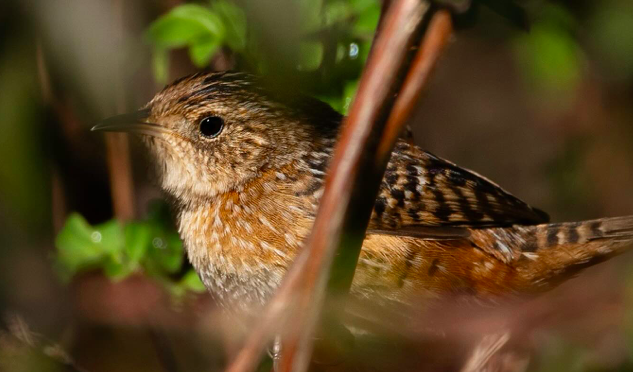To purchase prints of my artwork check this link to visit my online gallery https://SallySiko.zenfolio.com/bestlifebirdingartbysallysiko
Tag Archives: birding tour north carolina
Enjoying the Boat-tailed Grackle in eastern NC
By Sally Siko
Though they are a common sight along North Carolina’s beaches, I love taking photos of the Boat-tailed Grackles.
I spotted this handsome fella snacking on some sort of crustacean while birding in the OBX this past weekend.
It was neat to watch him pick his way through the seaweed that had washed up on the cove. The waves crashing just inches away, the grackle remained unbothered as it finally found a meal and gulped it down.

Boat-tailed Grackles are a permanent resident of North Carolina boasting a wide range that stretches from the coastline of New York, down into Florida and into east Texas.
They are found almost always near sources of water such as wetlands and coastal marshes, waterfowl impoundments, lakes, rivers, both the Atlantic and Gulf beaches, ponds and mudflats.


These sharp looking members of the blackbird family are omnivorous with a diet of coastal fare that consists of mussels, shrimp, frogs, aquatic insects, snails, crayfish, and even crabs.
When grabbing a meal away from the water, they will feed on grasshoppers, caterpillars, and the eggs of other birds.
During the winter months, they will supplement their diet with different kinds of seeds and grain to make up for the protein loss that may occur when their favorite prey becomes scarce in cold weather. This is why you’re likely to see more of them at your feeders in the wintertime if you live on the east coast.
When this happens large flocks can quickly inundate a backyard and go through all the available bird seed in a flash.
For that reason some people consider them pests but I think they are beautiful!
Photos by @sally_siko of @bestlife_birding on my mighty mirrorless monster, the @canonusa #R5
Eastern Bluebirds in central NC
By Sally Siko
While searching for Short eared Owls last week in Guilford County, I spotted a flock of a couple hundred Eastern Bluebirds that had taken control of the fields across from the GCF.
Walking through the grass, the Bluebirds were everywhere. Fluttering up ahead of me with each step, soaring low overhead as they searched the area for breakfast.
That vibrant blue color of their plumage really popped out against the warm toned sunlit grass!

Though they are indeed a common sight here in NC, I was happy to pause looking for the owls to snap off a couple photos of the Bluebirds instead.
It was fun to try and set my exposures juuuust right in order to capture those colors. Though many were hunkered down low, happily a couple of the Bluebirds obliged by posing oh so sweetly in the tall grass.
A nice reminder that while birding with a camera in hand, sometimes it’s about capturing the beauty of the moment rather than the rarity of the bird so time well spent IMO 😉

Now that winter is here, families of Bluebirds will form loose flocks to hunt for a meal over open fields, in agricultural areas as well as in stands of long leaf pines with other songbirds such as sparrows, Nuthatches and Pine Warblers.
They are true omnivores with a diet consisting of a mix of seeds, insects and fruits. Being able to digest nutrients from a wide variety of food sources means that the Eastern Bluebird can thrive here in North Carolina even during the coldest months when insects are scarce.
Plus the extra help that bird lovers provide by putting out suet (another favorite Bluebird snack) in their feeders during the wintertime helps a whole lot too 🙂
Photos by Sally Siko of @bestlife_birding captured on my mighty mirrorless monster, the @canonusa #R5
Why are Painted Buntings so colorful?
By Sally Siko
With every color of the rainbow showing in his plumage, the Painted Bunting is truly a stunning bird to photograph and see in real life.

But what makes the male Painted Buntings plumage so vibrant? As it turns out, it’s a combination of feather structure and three pigments which contribute to the colorful feathers found on these handsome birds: melanin, carotenoids and porphyrins.

*Melanin-Naturally produced by the birds displays as black, brown, red and pale yellow in feathers.
* Carotenoids- Birds which display the reds, oranges and yellows in their plumage is attributed to carotenoids when they eat specific plants or insects, like spiders or grasshoppers, which eat the carotenoids the birds need for their feather colors.
* Porphyrins- A modified amino acid producing pink, brown, red and green pigmentation.
*Feather structure-That bright blue to violet head color is actually a trick of the light. When sunlight passes through certain proteins and pockets of air trapped between feather barbules — tiny filaments extending from the barbs of a feather — it refracts, just like light passing through a prism.

Unfortunately since winter is here, most of the Painted Buntings have migrated south.
They will return to North & South Carolina in May and stick around through September-ish.
Look for these guys in our coastal areas in scrubby wet habitats, in the scrub brush just behind the sand dune line, at the edges of woods and flying over open tall-grass fields.
Btw, I’m planning on heading back out later this year to share these beauties with my tour guests so I’ve added new trips in 2024 to find the Painted Bunting in NC & SC.
If you’d like to join me, check out the link in my bio for more info and available group tour dates or feel free to shoot me a DM anytime if ya have any questions 🙂
Photos by @sally_siko of @bestlife_birding on my mighty mirrorless monster, the @canonusa #R5
Rare bird alert NC- A Sedge Wren in Durham
By Sally Siko
It’s been a good winter of birding so far.
Bird number 180 for the year appeared this morning in the form of a sweet looking Sedge Wren in Durham county NC.
My friend Corie and I spotted it next to a field flitting around in the tangled undergrowth of a sharp thorned bit of scrubby bush.
This little guy was (as is the case with many species of wrens) very, very vocal which made him easy to locate in the dense tangle.
Yet, actually getting a clean look at it (much less a decent photo lol) was difficult at best.
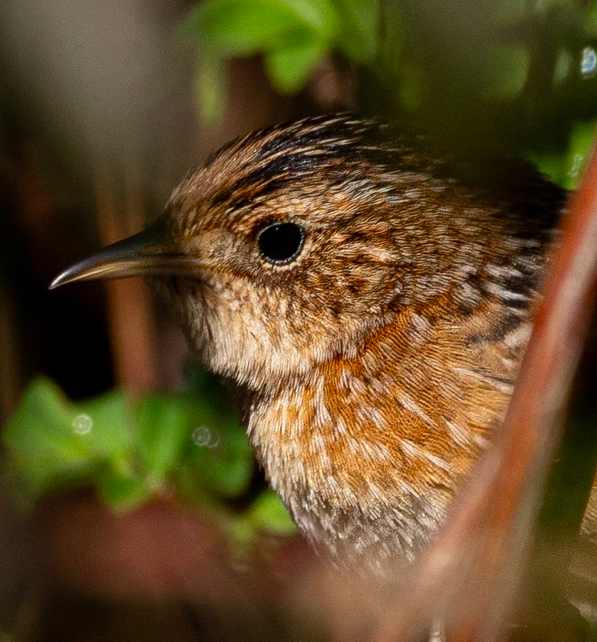
The problem was that the bird hardly sat still for more than three seconds. Making matters worse, in addition to all of the twigs and leaves between my lens and the bird, the light was very harsh with dark shadows, and blown highlights.
It took us around 45 minutes of waiting for the bird to pop out of the center of the bush, and even then there was always a twig or a leaf partially concealing the view.
In the end I was satisfied with the photos I was lucky to snap and grateful for the opportunity to even see this bird at all.
Success lol!
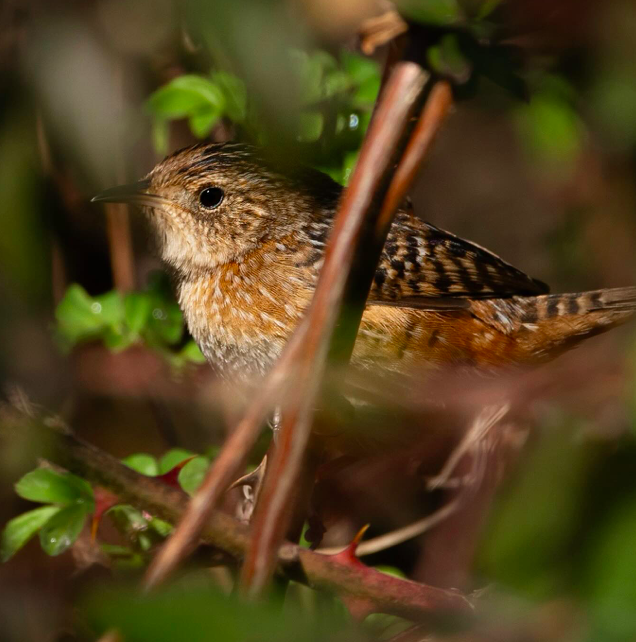

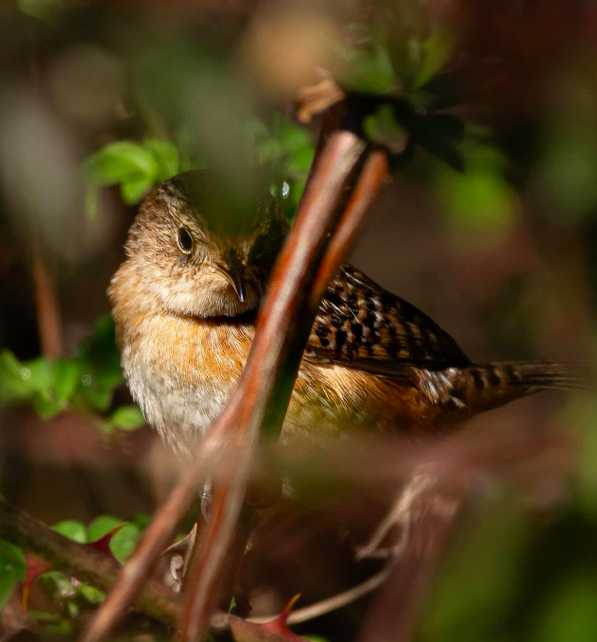
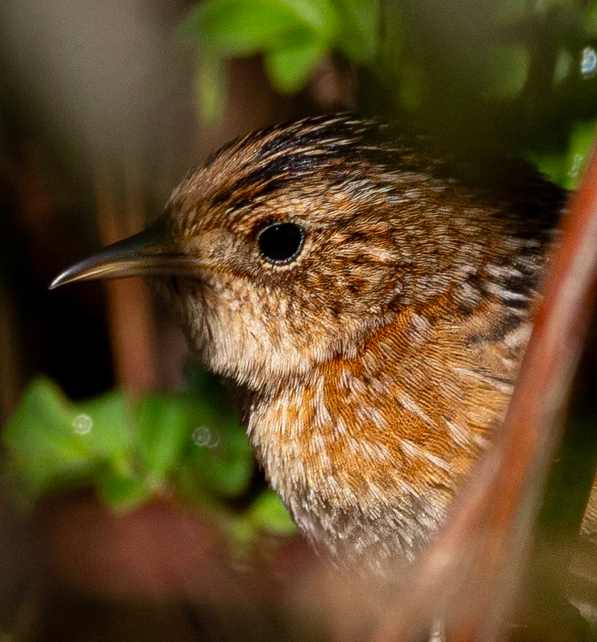

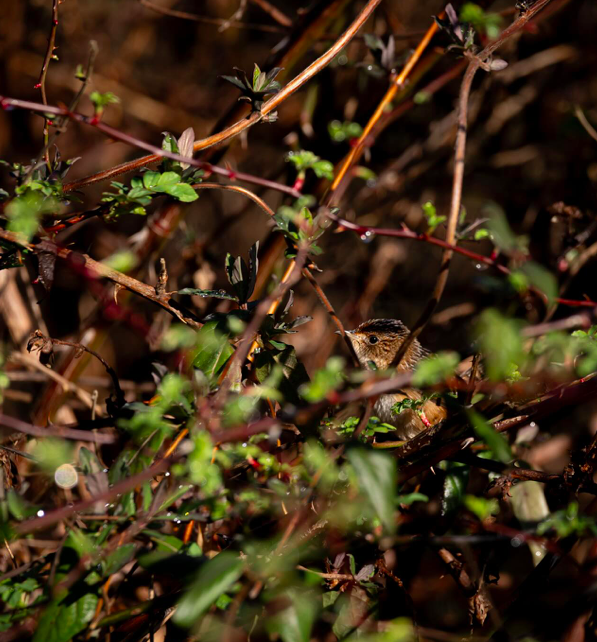
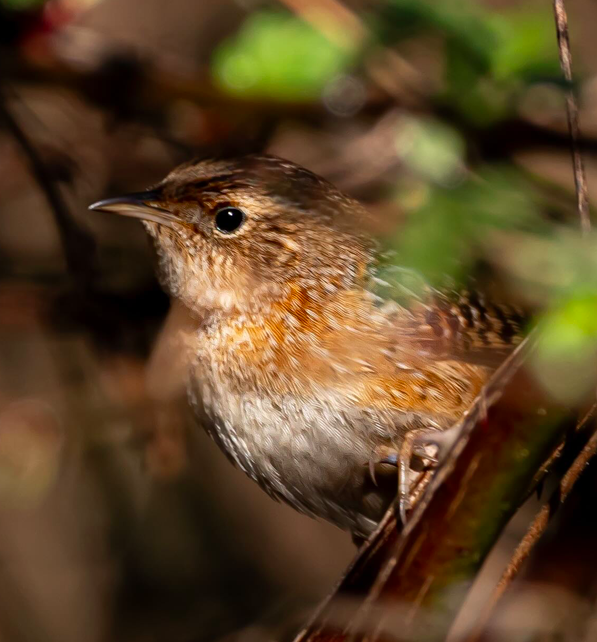

Sedge Wrens are a winter resident of North Carolina in our eastern counties.
Here in central NC, they are considered a rare sight so spotting one in the Durham area was a real treat.
They are best found in transitional areas where marshes blend into open fields and especially where there are patches of brush for them to hide and stalk prey.
Once called the Short-billed Marsh Wren, these birds are similar looking to the Carolina and Marsh Wrens we’ve got in NC.
Measuring about 4.5in long, Sedge wrens are streaked with black and brown plumage.
They’ve got white bellies and throats, with soft brown buff coloring on the sides and breasts.
Their tails have a black barring pattern on the topside.
What really stands out though is that bill which is noticeably shorter than that of its relatives.
What a cutie!
If you’d like to see this bird for yourself, I’ve attached a Google Maps pin to the birds location.
I hope that you get to see it too 🙂
Photos by @sally_siko of @bestlife_birding on my mighty mirrorless monster, the @canonusa #R5
North Carolina rare Bird Alert- A Cackling Goose at Mayo River State Park NC
By Sally Siko
Yesterday my friend Corie and I set out to check out a Cackling Goose that had reportedly been seen at the Mayo River SP in Mayodan, NC.
I had a feeling this bird would be a challenge to ID given their nearly identical appearance to the Canada Goose.
And I was right lol!

But what is a Cackling Goose anyway?
Well as you might have assumed by looking at it, these birds were once classified as Canada geese, but in 2004 the American Ornithological Society reclassified the four smallest subspecies of Canada geese as members of a new species known as the Cackling Goose.
Today, four subspecies of cackling geese are recognized by the AOS: the Bering, Aleutian, Richardson’s, and Taverner’s.
All four subspecies largely breed on the treeless tundra lands of Alaska and northern Canada. With the exception of the Richardson’s subspecies, the Cacklers are found almost exclusively in the Pacific Flyway areas.




To make matters more complicated, there are slight variations in the size and shape of the heads within the group of Cackler subspecies as well as subtle plumage variations too.
For what it’s worth, my instinct tells me that this is a Tavener’s Cackling Goose because this goose just looks so similar in proportion and plumage to that subspecies but that would be pretty unlikely given the spot where I found it.
Plus there’s a chance that this bird might just be (a very small sized) Canada Goose too lol.
I’m cool with being wrong with an ID but want to learn what to look for to get this species right going forward.
So bird friends, what do you think, is it a Cackling Goose or a Canada Goose?
Big props sent out if you can ID the subspecies too! Feel free to comment on this post.
I’ve included a Google Maps pin of the goose’s location for reference and in case you’d like to go see it for yourself.
Your opinion (and a detailed explanation) on this ID is much appreciated 🙂
Thank you.
Happy birding!
Photos by @sally_siko of @bestlife_birding on my mighty mirrorless monster, the @canonusa #R5
Short-eared Owls in Guilford County NC
By Sally Siko
Yesterday Michael and I got up early and drove up to the Guilford County Farm in Elon NC to see if we could spot a Short-eared Owl.
I’d seen reports of one hanging out there and since I’d never spotted one before, I figured it was worth the trip to try and this lifer to my list.
Once we arrived, we decided to walk through the fields to see if we could lay eyes on one sitting in the field.

Happily, it didn’t take but 15 minutes to spot one of these beauties taking off from the grass.
Although the Shortie was pretty far away and the photos I took aren’t the greatest it was a thrill to finally lay eyes on this beautiful bird!
But then it got even better as a second then third owl appeared swooping overhead!
Then things got really interesting as a flock of crows flew in and set off after the Shorties.
Diving and slicing through the air, the owls deftly out maneuvered the crows at every angle, eventually frustrating their pursuers into giving up.
That encounter is a good reminder in that if you ever want to find an owl, look (and listen) for a pack of angry crows!


Luckily for birders and photographers alike, Shorties are one of a handful of species of owls which can be seen flying over our marshes, un-filled waterfowl impoundments and wet fields during daylight hours (especially morning and in the afternoon).
They are more numerously found in our coastal counties especially at the Alligator River NWR and at Phelps Lake but may also be spotted (usually in smaller numbers) inland in agricultural areas throughout the Piedmont region.
Though there have been sporadic reports of this species breeding in the Tarheel state, Short-eared Owls are generally wintertime residents of North Carolina. Look for these beauties from now through late March.
If you’d like to make a trip out to the Guilford County Farm to see these guys for yourself, I’ve included a screenshot of their location in this post.
Good luck and happy birding!
Photos by Sally Siko of @bestlife_birding captured on my mighty mirrorless monster, the @canonusa #R5
By the way, I’ve added more that 80 new birding tour dates to my Best Life Birding trip schedule.
Check out the calendar below and book your next birding adventure with me today!
A White Ibis at Carolina Beach
By Sally Siko
Check out this handsome White Ibis.
I spotted him last week while birding on Carolina Beach. I’d stopped off at Carolina Beach lake to take a quick peek at the water to see if there were any interesting or unexpected birds flying around when a small flock of Ibis’s flew in and landed in the drainage creek on the eastern side of the lake.
Although I’ve seen hundreds of Ibises this year these birds were just so beautiful that I had to grab a few photos 🙂



White Ibis’s are a year round resident of North Carolina and are most commonly found in our eastern coastal counties. During the breeding season they are known to nest on our barrier islands with other shorebirds near the lower Cape Fear river area.
Now that winter is here, you can find them grazing in farm fields and foraging for a meal in freshwater & brackish suburban ponds, and waterfowl impoundments.


An opportunistic hunter of the shoreline, these handsome white birds enjoy a varied diet of crayfish, crabs, frogs, minnows, snakes and even insects. Look for them in the grass along the waters edge and wading through shallow, show moving waters.
Photos by Sally Siko of @bestlife_birding captured on my mighty mirrorless monster, the @canonusa #R5
By the way, I’ve added more that 80 new birding tour dates to my Best Life Birding trip schedule.
Check out the calendar below and book your next birding adventure with me today!
Spending time with Ruddy Turnstones in eastern NC
By Sally Siko
Here one of my favorite shorebirds, the Ruddy Turnstone.
I found this handsome little one on the jetty at Ft.Fisher near Wilmington NC.
I’d made the somewhat treacherous walk across the slippery jetty when I spotted this little guy picking along the waterline. What a beauty!
Swinging my camera onto my back, I hand over hand climbed down the side of the rocks to lay on the narrow strip of sand at its base in order to get these photos at eye level.
The nice thing was that this bird was quite amicable to my presence allowing a nice close up view from about 15 ft away.


Although they breed in the Arctic, Ruddy Turnstones may be found in the coastal areas of North Carolina throughout most of the year in varying numbers. They’re most often spotted on rocky jetty’s, inlets and saltwater shorelines with pebble beaches.
Interestingly their preference for foraging in these types of habitats is actually how they earned their name.
They’ll scour the shoreline flipping over stones, pebbles and shells to look for prey possibly hiding underneath. It’s a unique behavior that’s really neat to watch.



The Ruddy Turnstone is also nicknamed the calico cat of shorebirds. During the breeding season, both males and females have bright orange legs, an orange-and-black patterned back, white belly, and black-and-white face. As seen in these photos, their nonbreeding plumage look similar to their breeding attire, but during the winter it’s replaced with a warm brown rather than then that distinct orange and black color combination.
Since they have to walk on wet rocks, the pads of their orange feet are grooved plus their toenails are short and sharply curved which gives them added grip while walking on those slippery surfaces.
Such fascinating birds!
Photos by Sally Siko of @bestlife_birding captured on my mighty mirrorless monster, the @canonusa #R5
By the way, I’ve added more that 80 new birding tour dates to my Best Life Birding trip schedule.
Check out the calendar below and book your next birding adventure with me today!
Birding tour in eastern NC- birdwatching in the OBX
By Sally Siko





